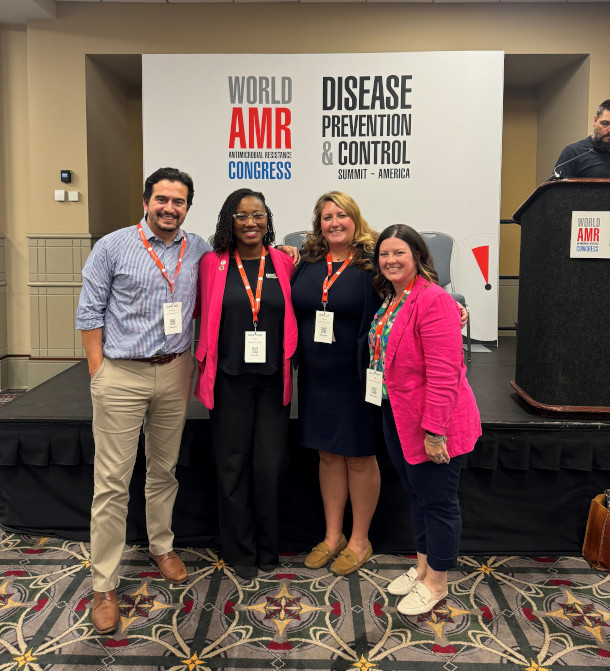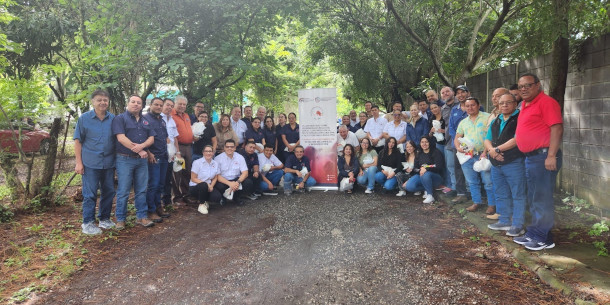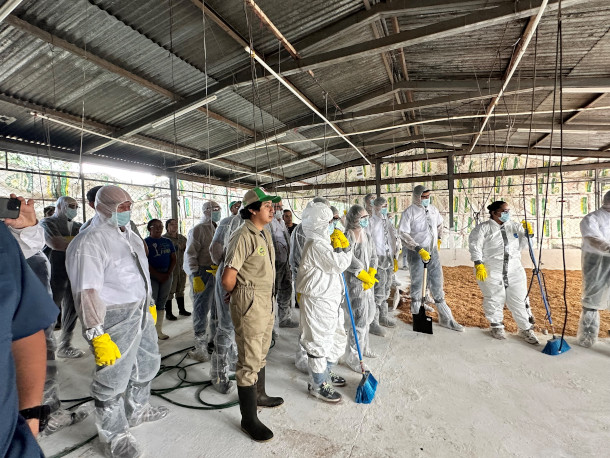Capital Update – For the Week Ending Sept. 6, 2024
In this week’s National Pork Producers Council (NPPC) Friday recap: NPPC leads coalition to appeal NFPA sprinkler decision; NPPC’s Dr. Johnson defends pork industry’s judicious antimicrobial use; NPPC’s Dr. Forseth participates in Swine Health Improvement Plan discussions; NPPC Drs. Johnson, Carr highlight U.S. pork priorities with Codex leadership; NPPC’s Zieba participates in foreign animal disease response workshops; and U.S. pork exports up in July. Take a deeper dive below.
NPPC leads coalition to appeal NFPA sprinkler decision | NPPC’s Dr. Johnson defends pork industry’s judicious antimicrobial use | NPPC’s Dr. Forseth participates in Swine Health Improvement Plan discussions | NPPC Drs. Johnson, Carr highlight U.S. pork priorities with Codex leadership | NPPC’s Zieba participates in foreign animal disease response workshops | U.S. pork exports up in July
NPPC Leads Coalition to Appeal NFPA Sprinkler Decision
What happened: NPPC Chief Legal Strategist Michael Formica in August led a coalition of agricultural groups in an appeal before the National Fire Protection Association (NFPA)’s Standards Council over a decision earlier this summer to change the fire code to require livestock barns to install sprinkler systems.
The coalition was supported in its appeal by the insurance industry, Farm Credit Council, the American Association of Swine Veterinarians, and others. The sprinkler requirement was championed by the Sprinkler Fitters Union and the Animal Welfare Institute (AWI). In 2012, NPPC was able to defeat an earlier version of this language that was introduced by the Humane Society of the United States.
Made up of representatives of the fire sprinkler industry and other fire professionals, the Standards Council has historically granted very few of the appeals that come before it.
NPPC’s detailed the numerous procedural irregularities in the development and adoption of the standard and providing examples of biosecurity risks and how sprinklers would do more harm in farm operations. NPPC discussed the need for data-driven fire solutions to better understand the cause of fires in barns and designing solutions to address those risks to prevent fires.
NPPC pointed out that AWI’s interests are putting farmers out of business, resulting in AWI revising their mission statement and the Sprinkler Fitters Union disassociated themselves from AWI during the hearing.
Why it matters: If allowed to stand, producers would begin to see state fire code changes after 2025 that require installation of fire sprinkler systems in new barns and those undergoing major retrofitting, such as conversions to meet California Proposition 12 standards.
Preliminary estimates have shown sprinkler systems to run approximately $9-$15 per square foot, which would also need to have a dedicated source of water to allow the system to run until the arrival of fire departments to extinguish the fire. Sprinkler systems also require periodic inspections and significant maintenance, especially in an environment such as a livestock barn, which creates biosecurity concerns.
Finally, NFPA research indicates that the operation of ventilation systems, in conjunction with a sprinkler, reduces the functionality and will likely shut down ventilation systems for sprinklers to work properly, creating severe animal welfare concerns.
NPPC’s take: The care and protection of their animals, including from fires, is the top priority for pork producers. The U.S pork industry spends almost a billion dollars annually to protect the biosecurity of their farms. The fire code includes numerous recommendations for the construction and design of barns, which pork producers, in conjunction with their insurers, already implement. A blanket sprinkler requirement for all farms, without a scientific basis and disregard of feasibility, is improper and should be reversed.
NPPC’s Dr. Johnson Defends Pork Industry’s Judicious Antimicrobial Use
What happened: Dr. Ashley Johnson, NPPC’s director of food policy, met with regulators and global stakeholders at the World Antimicrobial Resistance (AMR) Congress, a global conference where stakeholders in the AMR field come together to discuss and develop initiatives to address antimicrobial resistance.
Dr. Johnson defended the pork industry’s judicious use of antimicrobials and continued to push back on initiatives that could negatively impact pork producers such as target reductions of antimicrobials.
NPPC’s take: Pork producers use antimicrobials to ensure the health and well-being of their animals, which they have a moral obligation to raise humanely and compassionately. Healthy animals ensure safe food for consumers. NPPC advocates for science-based approaches to swine health and production and opposes efforts to dictate on-farm production practices.
Why it matters: The AMR Congress is an opportunity for the pork industry to share what it is doing to address AMR and to continue to advocate to regulators the judicious use of antimicrobials under a valid Veterinary Client-Patient Relationship. This week’s meeting is critical, as it is the final discussion prior to the high-level meeting on antimicrobial resistance that will take place in two weeks at the UN General Assembly, which will consider actions to set global initiatives that would directly impact a pork producer’s ability to judiciously use antimicrobials.

NPPC’s Dr. Johnson (second from right) and participants at the World AMR Congress.
NPPC’s Dr. Forseth Participates in Swine Health Improvement Plan Discussions
What happened: NPPC’s Dr. Anna Forseth, director of animal health, participated in the fourth annual House of Delegates meeting of the U.S. Swine Health Improvement Plan (U.S. SHIP) in Bloomington, Minnesota. U.S. SHIP is a collaborative effort among the pork industry and state and local partners to establish a platform for safeguarding, improving, and representing swine health.
Currently, the program objectives focus on development of African swine fever (ASF) and classical swine fever (CSF) certifications of U.S. pork production operations. The certifications are designed to designate freedom from disease (outside of foreign animal disease control areas) and support for interstate commerce and resumption of international trade following an ASF or CSF outbreak. Topics discussed at this year’s U.S. SHIP Houses of Delegates meeting included traceability, feed biosafety, biosecurity, feral swine mitigation, surveillance, elimination of Porcine Endemic Diarrhea, market haul sanitation, as well as updates from the exhibition sector.
NPPC’s take: NPPC will continue to support U.S. SHIP program development, appropriation of funds, and the transition of the program to the U.S. Department of Agriculture (USDA).
Why it matters: Focusing on surveillance, biosecurity and traceability, the U.S. SHIP program is being developed as a tool to demonstrate freedom of disease and expedite return to trade.
NPPC’s Drs. Johnson, Carr Highlight U.S. Pork Priorities with Codex Leadership
What happened: NPPC Director of Food Policy Dr. Ashley Johnson and Senior Director of International Technical Affairs Dr. Trachelle Carr met with UN Codex Alimentarius Commission (CAC) Chairman Steve Wearne and Mary Frances Lowe, the U.S. manager for the CAC at the U.S. Department of Agriculture.
The discussion highlighted the pork industry’s priorities of maintaining fair trading practices and to ensure global food safety regulations are based on science.
The Codex commission is the international food safety standards-setting body.
Why it matters: NPPC recognizes the critical role Codex serves to facilitate fair trade and protect consumer health through the development and use of science-based food safety standards and guidelines.
NPPC’s Zieba Participates in Foreign Animal Disease Response Workshops
What happened: NPPC Vice President of Government Affairs Maria C. Zieba participated in workshops in Guatemala related to improving African swine fever (ASF) and Classical swine fever (CSF) surveillance and related farm biosecurity.
The workshops, which are being conducted throughout Central America and the Caribbean, are a collaboration between NPPC and the International Regional Organisation for Plant and Animal Health (OIRSA), consisting of ministries and secretariats of agriculture and livestock from member states working to develop animal health, plant health, quarantine services, and food safety plans.
The courses held recently in Guatemala focused on animal disease surveillance, biosecurity, and diagnostics. In attendance were representatives from the veterinary offices of OIRSA member countries, veterinary students, and agricultural producers.
Why it matters: The NPPC-OIRSA partnership aims to improve regional detection and response to foreign animal disease threats to countries including Belize, Costa Rica, Dominican Republic, El Salvador, Guatemala, Honduras, Mexico, Nicaragua, and Panama — by promoting healthy agricultural production in harmony with the environment and facilitating international trade.

NPPC’s Zieba and OIRSA participants in Guatemala.
OIRSA participants demonstrate cleaning and disinfecting exercises.

U.S. Pork Exports Up in July
What happened: July pork exports were higher than a year ago — up 10% in volume and 13% in value — through the first seven months of the year, they were 4.2% higher in volume and 6.2% in value compared with 2023’s record pace over the same period. Exports topped 1.29 million metric tons (MT) and $4.97 billion, according to data from the U.S. Department of Agriculture compiled by the U.S. Meat Export Federation.
Mexico continued to be the No. 1 export market for U.S. pork, with volume in July of more than 100,000 MT and value at nearly $244 million. Rising 24% in volume and 29% in value compared to last July. January-July exports were more than 663,000 MT, up 8.1% from a year ago, while value rose 15.2% to $1.45 billion.
Other markets that saw strong export growth in July were South Korea, which took 13,674 MT worth over $49 million, soaring up 16% and 30% higher than a year ago. Year to date through July, exports to the Asian nation were 31.4% above last year’s pace and value was up 37.5% to $508.87 million.
July exports to Australia were up slightly, with January-July, exports up 36.3% in volume and 41.5% in value, climbing to $194.06 million. The Philippines, Malaysia, and Vietnam took exports for the first seven months of the year of 31,715 MT down 2.1% valued at $45.09 million, up 8.6%. Pork exports to Colombia were strong in July, climbing 10.9% from a year ago to 8,569 MT, while value increased 16% to $24.79 million. January-July exports increased 29.5% in volume and 39.8% in value to $182.27 million.
Why it matters: The total value of pork and variety meat exports in July equated to an average of $66.52 in value from each hog that was marketed, while the January-July average was $66.54, up 3% from the same period a year ago. Exports accounted for 25.2% of total carcass weight production in July and 25.7% of production for the first seven months of 2024.